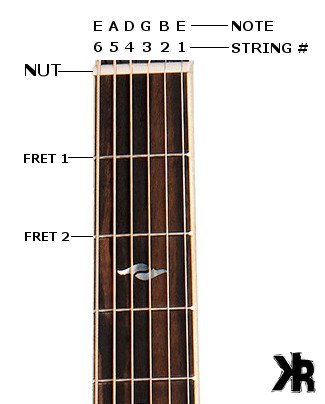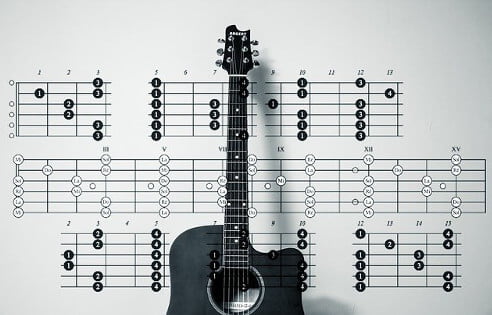Table of Contents
Learning to play the guitar can be a rewarding and enjoyable experience. One of the first and most essential steps is familiarizing yourself with the names of the strings on the guitar.
This knowledge lays the foundation for everything else you’ll learn. From playing chords and scales to understanding music theory.
My aim is to provide a clear and concise guide to guitar string names. How to memorize them, and the importance of understanding string numbering.
By the end of this Killer Rig article, you’ll have the necessary information to confidently identify and recall the names of each string.
With consistent practice, this knowledge will soon become second nature. Allowing you to focus on developing your playing skills and musical knowledge. So let’s dive in and explore the guitar string names!
String Name Summary
- A guitar in standard tuning has strings named after the musical notes they represent. When played open, they are: E (low pitch), A, D, G, B, and E (high).
- Guitar strings are numbered in reverse order of their pitch. The 1st string being the thinnest (high E). And the 6th string being the thickest (low E).
- Mnemonics, such as the phrase “Eddie Ate Dynamite, Good Bye Eddie,” are useful memory aids. They can help you remember the guitar string names.
- Regular practice and repetition are crucial for solidifying your understanding of guitar string names.
- Knowing the names and numbers of guitar strings will improve your ability to read sheet music, play chords, and communicate effectively with other musicians.
The String Names in Standard Guitar Tuning
It’s crucial to familiarize yourself with the names of the guitar strings. Well before learning to strum or even work on your favorite songs.
This will make it easy to then pick up and play music as you move along in your journey. You would be surprised how many players don’t know the string names on the guitar! But it’s important to know that these names or notes are only correct when in standard guitar tuning.
If you change the tuning of your guitar, the names of each note will also be adjusted.
Six-string Guitar
If you’re just starting out, you’ll likely be using a six-string guitar. It’s the most common type for beginners and experienced players alike. These guitars are versatile and can be found in various styles. This includes acoustic, electric, and classical.
Learning the notes on one will translate over to any other as long as it’s tuned to standard. Then, should you decide to play one with more strings, it will be easier to understand it. This is part of the versatility of sounds with the guitar and why I love it.
If you are interested in lower tunings, try C sharp. It’s similar to standard, but deeper in tone.
String Names from Lowest to Highest Pitch
The six strings on a standard guitar are named based on the musical notes they represent. But only when played open, meaning without pressing down any frets.
Starting from the thickest string (closest to your head when you’re holding the guitar). And moving towards the thinnest string (closest to the floor), the names are as follows:
- E (low): This is the thickest string and produces the lowest pitch. It’s often referred to as the “low E” or “6th string.”
- A string: The second-thickest, also known as the “5th string.”
- D string: This is the middle string in terms of thickness. It’s referred to as the “4th string.”
- G string: The third-thinnest, commonly called the “3rd string.”
- B string: This string is the second thinnest. It’s known as the “2nd string.”
- E (high): The thinnest string, it produces the highest pitch among all six. It’s often referred to as the “high E” or “1st string.”

You may have noticed that I describe the strings in terms of thickness. But what truly determines their pitch is their tension and mass.
The thicker strings have more mass. This requires more tension to produce a specific pitch, resulting in a lower sound. The thinner strings have less mass, requiring lower tension to produce a higher pitch.
To remember the order of the string names easily, think of the phrase: “Eddie Ate Dynamite, Good Bye Eddie” (E, A, D, G, B, E).
This fun and memorable sentence will help you quickly recall the names of the strings as you progress on your guitar journey. We will touch on more mnemonics later on in the article.
You should now have a basic understanding of the standard guitar string names. But let’s move on to numbering the strings. This is equally important! It will help you communicate more effectively with other musicians. While also making learning new songs or techniques easier.
Numbering the Strings
When learning to play the guitar, it’s also important to understand string numbering. This numbering system allows for easier communication between musicians. But also simplifies the process of learning new techniques, songs, or exercises.
Let’s explore how the strings are numbered. Then explore why this knowledge is essential for your growth as a guitarist.
Explanation of String Numbering
The strings on a guitar are numbered in reverse order of their pitch. Meaning, the thinnest one (high E) is the 1st string. But the thickest one (low E) is the 6th string. Here’s a breakdown of the numbering:
- 1st string: E (high pitch).
- 2nd string: B.
- 3rd string: G.
- 4th string: D.
- 5th string: A.
- 6th string: E (low pitch).
Remembering the string numbering is as simple as counting from the thinnest one to the thickest. When combined with the string names, this system provides a clear and organized arrangement. It’s the best way to identify and discuss each string on the guitar.
Importance of Understanding String Numbering
Understanding the string numbering system is crucial for several reasons:
- Sheet music and tablature: Knowing the string numbering will help you quickly identify which string to play for a particular note or chord. This is crucial when reading sheet music or tablature.
- Chord diagrams: Chord diagrams use string numbers to show you how to play them. This makes it essential to know the numbering system to play chords correctly.
- Communication: Knowing the string numbering allows for clear and efficient communication. This is important when discussing techniques, songs, or exercises with fellow musicians.
You should now know the string names and their numbering. But let’s explore some techniques that will help you memorize this information quickly and effectively. In the next section, we’ll discuss the use of mnemonics. This will help to make recalling string names and numbers a breeze.
Mnemonics for Memorizing Guitar String Names
Mnemonics are memory aids. They can help you recall information more easily. And so they are an excellent tool for learning and remembering guitar string names. By using a catchy phrase or acronym, you can quickly associate the first letter of each word with the corresponding string names.
In this section, I’ll explore some popular mnemonics. Then, provide guidance on creating your own. It will help make memorizing guitar string names a fun and engaging process.
Importance of Mnemonics
Mnemonics play a significant role in the learning process. They transform abstract information, like guitar string names, into something easier to recall. Using mnemonics to memorize string names can:
- Improve your memory retention and recall speed.
- Make the learning process more enjoyable and engaging.
- Help you establish a stronger connection with the instrument. You’ll have a personalized memory aid to associate with the guitar strings.

Popular Mnemonics
Here are some widely-used mnemonics for remembering the guitar string names. From the 6th (low pitch) to the 1st string (high E):
- Every Apple Does Good Being Eaten (EADGBE).
- Eat All Day Get Big Easy.
- Elephants And Donkeys Grow Big Ears.
Feel free to choose one of these popular mnemonics or create something that resonates with you personally.
Tips for Practicing String Names
So you have selected a mnemonic to help you remember guitar string names! Now it’s time to put that knowledge into practice. Regular practice is essential for solidifying your understanding of string names. But also their corresponding numbers.
In this section, I’ll provide some practical tips and strategies for practicing string names. Making the learning process more efficient and enjoyable.
Visualize the Fretboard
Visualization is a powerful learning tool. This can help you reinforce your understanding of guitar string names. Try to picture the guitar fretboard in your mind, with each string labeled with its name and number.
Practice this mental exercise regularly! Even when you’re away from your guitar, to help solidify your knowledge.
Say the String Names Out Loud while Playing
When you’re practicing on your guitar, say the string names out loud as you play them. This not only helps you remember the names.
But also creates a stronger connection between the physical act of playing and the mental process of recalling string names. By verbalizing the string names, you’re engaging multiple senses. It reinforces your memory through repetition.
Use Flashcards or Smartphone Apps
Flashcards and smartphone apps can be valuable resources. Especially for practicing guitar string names. Create a set of flashcards with the string names and numbers, and test yourself regularly.
Alternatively, search for guitar learning apps that include string name exercises or quizzes. These tools will help keep your practice sessions varied and engaging. While testing your knowledge and recall abilities.
Consistent Practice
Like any skill, mastering guitar string names requires consistent practice. Make it a part of your daily routine, even if it’s just for a few minutes. Over time, you’ll find that recalling string names and numbers becomes second nature.
Allowing you to focus on other aspects of playing the guitar. Things like chords, scales, and techniques. With these practice tips in mind, you’ll be well on your way to mastering the guitar string names! But also becoming a more confident and knowledgeable guitarist.
Conclusion
We’ve covered the essential information you need to know about guitar string names. By understanding the name and number system, you have laid the foundation for your journey as a guitarist.
We’ve also discussed mnemonics! A powerful memory aid that can help you quickly recall string names. As you continue on your guitar journey, keep in mind that learning and mastering an instrument is a gradual process. Stay patient, enjoy the learning experience, and celebrate your progress.
With dedication and practice, you’ll soon be playing your favorite songs and exploring new musical horizons. Be sure to carry on with your learning by reading these articles:
FAQs
Can you play a guitar if you don’t know the string names?
Yes, you can play the guitar without knowing the string names, but it will limit your ability to communicate with other musicians and may slow down your learning process. Knowing the string names is fundamental for tuning and understanding chords and scales.
What happens if you tune the strings incorrectly?
Tuning the strings incorrectly can result in poor sound quality and may even damage the guitar over time. Incorrect tuning can also make it difficult to play along with other instruments or backing tracks.
Is it necessary to understand music theory to play the guitar?
Understanding music theory is not strictly necessary to play the guitar, but it can enhance your understanding and interpretation of music. It can also make it easier to learn new songs and compose your own.
